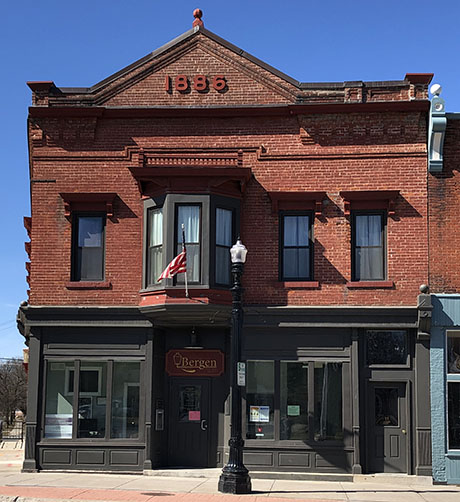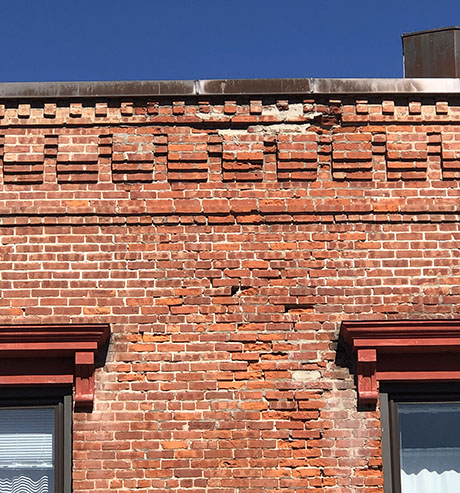Tulley Building in Bergen needs restoration, mayor seeking a grant

One of the most historic buildings in the village of Bergen is the focus of a new project by Mayor Anna Marie Barclay.
Obtaining a grant to restore the Tulley Building at the corner of Lake Street and Buffalo Road is one in a string of many grants Barclay has obtained since becoming mayor in 2014.
The brick on the Tulley Building is in need of repair and Barclay is working with the Western New York Landmark Society to complete the application for a Genesee Valley Rural Revitalization Grant in the amount of $50,000. That would pay for 90 percent of the project, Barclay said.
“Tulley is the cornerstone of the village of Bergen Lake Street Historic District,” Barclay said. “It is the village-owned building which houses the village offices, public, commercial and residential space.”
Throughout the years, the Tulley building, built-in 1886, has been home to Tulley’s Hardware, Best’s Furniture Store, a Flour and Feed Store, Edgerton Dry Goods Store, Palace of Sweets, saloon and bowling alley, Gregory's Bakery and Cafe, Kevin Russell Hardware and Plumbing, Treasured Images and an ice cream shop. The second floor has been used as a dance hall, millinery shop, barbershop, firemen’s meeting hall, telephone office, office of the Bergen herald, dentist’s office, and apartments.
The village purchased the building in 2006 in the hopes that restoring and repurposing it would decrease the calls to “tear down and replace the obsolete building,” Barclay said. It was their hope the building would serve as an inspirational cornerstone.
A year later as a village board member, Barclay chaired the Tulley Building Restoration Committee, which was formed in 2007 to develop a renovation plan that would ensure the historic integrity of the building would be maintained, and that the building would encourage increased community activity in the village business district, increase a sense of pride within the community, attract new businesses and act as a catalyst to the restoration of other buildings.
Since then, structural restoration has been completed, a new roof installed and first floor commercial area behind the village office space has been restored. Both the east and south facades have been restored and painted, and a mural reflecting Bergen’s history has been added to the south façade.
Slowly, but surely other building owners have followed suit and enhanced the appearance of their buildings. This was accomplished in part by another grant Barclay secured, after several years of applying.
“Others bought buildings with restoration in mind and signed on to participate in the Main Street Grant program,” Barclay said. “The initial Tulley Building was a catalyst to revitalize the historic district. Now the cornerstone building is once again in danger. The proposed Tulley project will help keep our historic downtown economically viable. Our growing sense of place and pride and positive community identity is evident as our buildings are renovated. The Tulley project will enhance this. The project complements place-based economic growth and will add to the architectural and visual richness of the community. The economic value to the village of the Tulley project is immeasurable, as it enhances the work completed on other historic buildings through the Main Street Grant projects.”
Barclay continues to say there is positive economic development momentum which has already drawn several new businesses, walkers and tourists who patronize those businesses, new residents to downtown, and increased property values as these renovations progress. As stated in the 2016 Comprehensive Plan, restoration and preservation of village historic buildings will encourage the development of new businesses, bring more patrons to existing businesses and invite renters to renovated apartments.
The Tulley Building is brick-faced and covered with porous brick produced in Bergen in the late 1800s. Many bricks are loose and deteriorating, causing pieces and dust to fall to the sidewalk, leaving areas of the historic brickwork damaged, Barclay said. Birds are nesting in areas of broken or missing brick, increasing the damage. The domino effect of missing brick exposing other brick to water damage is causing large cracks to occur in the wall. The brick pattern work under the roof edge is noticeably crumbling, and sections of mortar are missing leaving the bricks open to further damage and continued loss of the Victorian brick features. Sections of brick surrounding the windows are equally damaged. This deterioration of the brick surface is allowing for water to seep through to the interior surfaces, which have needed to be replaced.
The Tulley Block project will include the replacing of missing and damaged bricks and repointing of mortar on the east and south walls of the building. A schematic drawing of the painting design of historic features of the building will be done by an architect, and paint and supplies will be purchased through the grant opportunity. Village staff will paint the building according to the drawings. Specifics of the masonry work by accredited historic masons will include removal and replacement of approximately 30 damaged bricks, tuck pointing at damaged locations of 515 linear feet, all mortar joints cleaned and filled, all dust and debris cleaned from the work area, stain removal completed in all portions of the walls and preservation of the bricks to stop further deterioration and prevent water seepage.
The village has had to replace interior walls on the south side of the building and mitigate mold due to water seepage, Barclay said. Painting of the non-brick historic features of the south and east walls will be a complement to the work completed on the historic buildings involved in the Main Street grant project.
Part two of this work is to update and expand the Lake Street Historic District, Barclay said.
“We have just completed the Main Street Project funded through the New York State Main Street Funding Program, which allows the village to move forward with this process without an extensive cultural resource survey. This will broaden opportunities for homeowners in the expanded district.”
Barclay said Bergen is a very small community and in the past was often passed over for grants which were available to larger communities.
“To show we are deserving and ready for support that grants provide, I initiated the comprehensive plan in 2016,” Barclay said. “I also initiated the Park Committee and Tree Board, which gave credibility to our grant applications.”
She also stressed the village no longer pays the exorbitant fees for a grant writer, as she has written 90 percent of the grant applications they have submitted and secured.
“Through my work, the village has secured more than $1.6 million in grants,” Barclay said.
These include $778,843 for Infrastructure; $527,750 for Historic Restoration; $161,940 for Parks and Recreation; $83,200 for Community; and $60,000 for Engineering Planning (written by Clarke, Patterson and Lee).
While the Tulley Building restoration is a priority, it is not the only thing Barclay is hoping to accomplish. She has a bucket list of additional projects to benefit the village, which includes improvements at the Waste Water Treatment Plant, new restrooms in Hickory Park, a Historic Resource survey for New York state/Federal tax credits to homeowners, sponsoring an internship for historic documents and hiring of a village historian.
Photos courtesy of Anna Marie Barclay

Cracks in the mortar and missing bricks are evident in this photo of the Tulley Building. Mayor Anna Marie Barclay is working to secure a grant to pay for restoration work.
